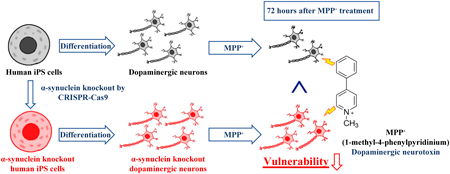- 著者
- Shizen Inoue Kaneyasu Nishimura Serina Gima Mai Nakano Kazuyuki Takata
- 出版者
- The Pharmaceutical Society of Japan
- 雑誌
- Biological and Pharmaceutical Bulletin (ISSN:09186158)
- 巻号頁・発行日
- vol.46, no.3, pp.517-522, 2023-03-01 (Released:2023-03-01)
- 参考文献数
- 20
- 被引用文献数
- 3
Parkinson’s disease (PD) is an age-related disorder with selective dopaminergic (DA) neuronal degeneration in the substantia nigra pars compacta. The presence of mainly α-synuclein-composed Lewy bodies in DA neurons is among the disease hallmarks in the brain of patients with PD. Human induced pluripotent stem cells (hiPSCs) are powerful tools to investigate PD pathophysiology and understand its molecular and cellular mechanisms better. In this study, we generated an α-synuclein-null hiPSC line introducing a nonsense mutation in the α-synuclein-encoding SNCA alleles using clustered regularly interspaced short palindromic repeats CRISPR-associated protein 9 (CRISPR-Cas9)-mediated gene editing. Our Western blotting analysis revealed the lack of α-synuclein protein expression in SNCA knockout hiPSC-derived cells. In addition, SNCA knockout hiPSCs retained healthy cell morphology, undifferentiated marker gene (e.g., NANOG, POU5F1, and SOX2) expression, and differentiation ability (based on the marker gene expression levels of the three germ layers). Finally, SNCA knockout hiPSC-derived DA neurons exhibited reduced vulnerability to the DA neurotoxin, 1-methyl-4-phenylpyridinium. In conclusion, the SNCA knockout hiPSC line we generated would provide a useful experimental tool for studying the physiological and pathological role of α-synuclein in PD.
